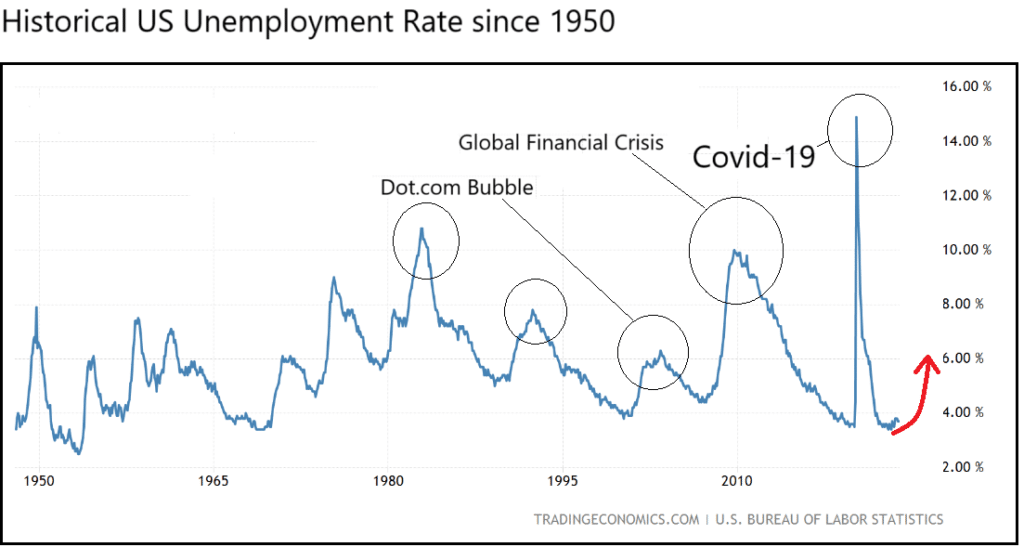Economic Overview; 2024 Unemployment Rate Forecast
- Publication Date: 02/12/2024
Executive Summary
In the ever-evolving economic landscape of the United States, the unemployment rate serves as a key indicator of the nation's fiscal health and labor market dynamics. Historically, fluctuations in this metric have been closely watched by policymakers, investors, and economists alike for insights into broader economic trends. This article delves into the historical patterns of the U.S. unemployment rate, projects a notable increase to 6% in 2024 from its current levels, and explores the ramifications of this trend on the investment markets.


Historical Overview of U.S. Unemployment Rates
The U.S. unemployment rate has experienced significant fluctuations over the decades, influenced by a myriad of economic, political, and social factors. From the Great Depression's peak in the 1930s, where rates soared above 20%, to the more recent COVID-19 pandemic, which saw a sudden spike to 14.8% in April 2020, the journey has been tumultuous. Post-pandemic recovery efforts have seen a remarkable decrease, stabilizing at much lower levels. However, understanding these historical movements requires an analysis of the interplay between fiscal policies, global economic conditions, technological advancements, and labor market dynamics.
Factors Leading to a Projected Increase in 2024
Several key factors contribute to the projected increase in the unemployment rate to 6% in 2024:
Economic Slowdown:
Predictions of an economic downturn, driven by reduced consumer spending and tightened monetary policies aimed at curbing inflation, suggest a cooling labor market.
Technological Displacement:
The acceleration of automation and artificial intelligence in various industries is expected to displace a significant portion of the workforce. This trend will probably start from the tech sector itself which is the home to advancement of AI.
Global Trade Dynamics:
Ongoing trade tensions and shifts in global supply chains may impact domestic employment in sectors reliant on international markets.
Policy Adjustments:
Anticipated changes in fiscal and monetary policy may lead to adjustments in hiring practices and labor demand.
Impact on Investment Markets
The projected uptick in unemployment rates poses both challenges and opportunities for investment markets:
Consumer Discretionary Sector:
Higher unemployment may lead to reduced consumer spending, impacting companies within the consumer discretionary sector negatively.
Defensive Stocks:
Historically, sectors such as utilities and consumer staples, which are less sensitive to economic cycles, may see increased interest from investors seeking stability.
Interest Rates and Fixed Income Markets:
The Federal Reserve's response to rising unemployment, potentially through adjusting interest rates, will influence bond yields and the attractiveness of fixed income investments.
Innovation and Growth Sectors:
Contrarily, sectors poised for growth, such as technology and renewable energy, might attract forward-looking investments, anticipating long-term trends beyond immediate economic contractions.
Conclusion
The forecasted increase in the U.S. unemployment rate to 6% in 2024 underscores the importance of vigilant economic monitoring and adaptive investment strategies. By examining historical patterns and considering the multifaceted impacts of unemployment fluctuations, investors can navigate the uncertainties of the market with greater insight and foresight. As the situation unfolds, the resilience of the U.S. economy and the agility of its labor market will be pivotal in shaping the investment landscape in 2024 and beyond.
CONTACT US
The Scholarch LLC
1111B Governors Ave. STE 7059 Dover, DE 19904
research@thescholarch.com
Disclaimer: The Scholarch Reports upholds the highest standards of integrity and transparency in all its publications. We unequivocally assert that the content within our research articles is authentic and genuine, steadfastly adhering to the principles of impartiality and objectivity. Our commentary and analysis are conducted disinterestedly, devoid of any personal or financial interests that might potentially skew our evaluations. It is our policy not to invest in the stock ideas we report on. Should an exception arise, it will be clearly disclosed at the conclusion of our reports or articles. The insights and assessments provided in our research articles and reports are the culmination of meticulous research, intended solely for informational and educational purposes. They are not promotional in nature and should not be interpreted as an endorsement or solicitation to buy or sell any stocks, financial products, or services. The content provided on our website or in our reports does not constitute investment advice or an endorsement of any specific investment strategy. While we endeavor to provide accurate and up-to-date information, The Scholarch LLC and its affiliates do not guarantee its completeness or accuracy. We shall not be held accountable for any losses incurred from reliance on this information. Past performance is not a reliable indicator of future results. Readers are strongly advised to conduct their own due diligence and consult with a professional advisor before making any investment decisions. The Scholarch LLC does not possess a financial advisory license and therefore does not offer personalized financial advice. This website and our reports may include links to third-party websites and information; The Scholarch LLC is not liable for their content or accuracy. We appreciate your trust in The Scholarch Reports. Thank you for reading our disclaimer.

